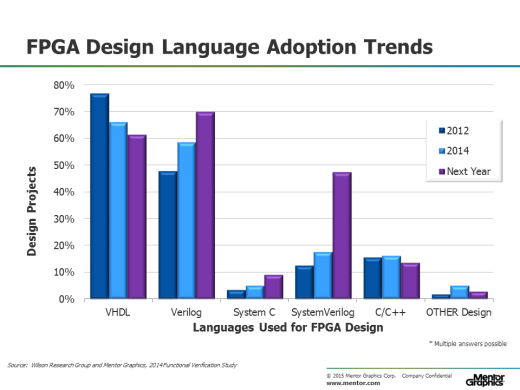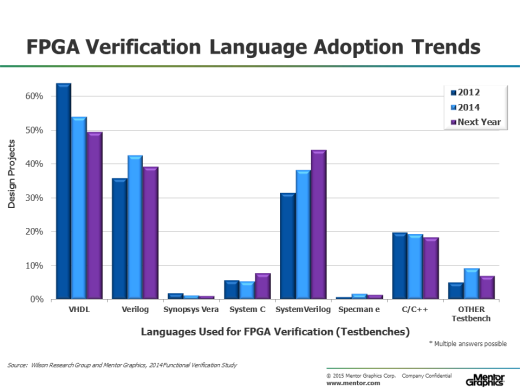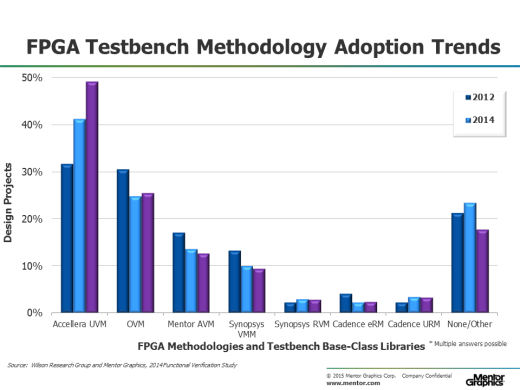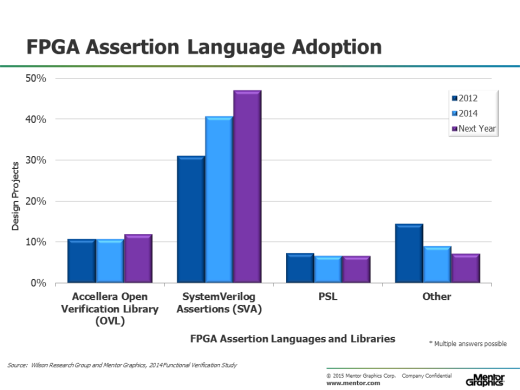Part 6: The 2014 Wilson Research Group Functional Verification Study
FPGA Language and Library Trends
This blog is a continuation of a series of blogs related to the 2014 Wilson Research Group Functional Verification Study (click here). In my previous blog (click here), I focused on FPGA verification techniques and technologies adoption trends, as identified by the 2014 Wilson Research Group study. In this blog, I’ll present FPGA design and verification language trends, as identified by the Wilson Research Group study.
You might note that the percentage for some of the language and library data that I present sums to more than one hundred percent. The reason for this is that many FPGA projects today use multiple languages.
FPGA RTL Design Language Adoption Trends
Let’s begin by examining the languages used for FPGA RTL design. Figure 1 shows the trends in terms of languages used for design, by comparing the 2012 Wilson Research Group study (in dark blue), the 2014 Wilson Research Group study (in light blue), as well as the projected design language adoption trends within the next twelve months (in purple). Note that the language adoption is declining for most of the languages used for FPGA design with the exception of Verilog and SystemVerilog.
Also, it’s important to note that this study focused on languages used for RTL design. We have conducted a few informal studies related to languages used for architectural modeling—and it’s not too big of a surprise that we see increased adoption of C/C++ and SystemC in that space. However, since those studies have (thus far) been informal and not as rigorously executed as the Wilson Research Group study, I have decided to withhold that data until a more formal study can be executed related to architectural modeling and virtual prototyping.
 Figure 1. Trends in languages used for FPGA design
Figure 1. Trends in languages used for FPGA design
It’s not too big of a surprise that VHDL is the predominant language used for FPGA RTL design, although the projected trend is that Verilog will likely overtake VHDL in terms of the predominate language used for FPGA design in the near future.
FPGA Verification Language Adoption Trends
Next, let’s look at the languages used to verify FPGA designs (that is, languages used to create simulation testbenches). Figure 2 shows the trends in terms of languages used to create simulation testbenches by comparing the 2012 Wilson Research Group study (in dark blue), the 2014 Wilson Research Group study (in light blue), as well as the projected verification language adoption trends within the next twelve months (in purple).
 Figure 2. Trends in languages used in verification to create FPGA simulation testbenches
Figure 2. Trends in languages used in verification to create FPGA simulation testbenches
FPGA Testbench Methodology Class Library Adoption Trends
Now let’s look at testbench methodology and class library adoption for FPGA designs. Figure 3 shows the trends in terms of methodology and class library adoption by comparing the 2012 Wilson Research Group study (in dark blue), the 2014 Wilson Research Group study (in light blue), as well as the projected verification language adoption trends within the next twelve months (in purple).
 Figure 3. FPGA methodology and class library adoption trends
Figure 3. FPGA methodology and class library adoption trends
Today, we see a downward trend in terms of adoption of all testbench methodologies and class libraries with the exception of UVM, which has increased by 28 percent since 2012. The study participants were also asked what they plan to use within the next 12 months, and based on the responses, UVM is projected to increase an additional 20 percent.
FPGA Assertion Language and Library Adoption Trends
Finally, let’s examine assertion language and library adoption for FPGA designs. The 2014 Wilson Research Group study found that 44 percent of all the FPGA projects have adopted assertion-based verification (ABV) as part of their verification strategy. The data presented in this section shows the assertion language and library adoption trends related to those participants who have adopted ABV.
Figure 4 shows the trends in terms of assertion language and library adoption by comparing the 2010 Wilson Research Group study (in dark blue), the 2012 Wilson Research Group study (in green), and the projected adoption trends within the next 12 months (in purple). The adoption of SVA continues to increase, while other assertion languages and libraries either remain flat or decline.
 Figure 4. Trends in assertion language and library adoption for FPGA designs
Figure 4. Trends in assertion language and library adoption for FPGA designs
In my next blog (click here), I will shift the focus of this series of blogs and start to present the ASIC/IC findings from the 2014 Wilson Research Group Functional Verification Study.
Quick links to the 2014 Wilson Research Group Study results
- Prologue: The 2014 Wilson Research Group Functional Verification Study
- Understanding and Minimizing Study Bias
- Part 1 – FPGA Design Trends
- Part 2 – FPGA Verification Effort Trends
- Part 3 – FPGA Verification Effort Trends (Continued)
- Part 4 – FPGA Verification Effectiveness Trends
- Part 5 – FPGA Verification Technology Adoption Trends
- Part 6 – FPGA Verification Language and Library Adoption Trends
- Part 7 – ASIC/IC Design Trends
- Part 8 – ASIC/IC Resource Trends
- Part 9 – ASIC/IC Verification Technology Adoption Trends
- Part 10 – ASIC/IC Language and Library Adoption Trends
- Part 11 – ASIC/IC Power Management Trends
- Part 12 – ASIC/IC Verification Results Trends
- Conclusion: The 2014 Wilson Research Group Functional Verification Study
Comments
Leave a Reply
You must be logged in to post a comment.



I always enjoy reading Harry’s reports on these studies. .
Fascinating to see the upward trend for both SystemVerilog and UVM in the FPGA space. I can’t wait to see the 2016 study numbers!
I have a mini-paper, Cliff-Note #3 on my web page that describes why it is no longer reasonable to limit FPGA testing to prototyping in the lab.
Nice job, Harry.
I look forward to your additional blogs from the 2014 study.
Regards – Cliff
Harry,
I have observed a trend that the companies using VHDL as the language for design (while the slides here talk about design for FPGA, it is highly likely that the same design would be targeted to ASIC too) also traditionally use FPGA as the primary vehicle for verification. Many of those companies have been reluctant to embrace Constrained Random Verification so far. Also this points to specific geographies too. Would you be able to share some insights into this?
Thanks in advance
Gaurav Jalan
http://whatisverification.blogspot.in
I plan to start releasing the ASIC data this week.
Note: I plan to start releasing the ASIC data this week.
In general, I am seeing an increase adoption of constrained random on FPGA projects in all regions of the world. What is driving this is not so much targeted languages for implementation or verification…but increased complexity of FPGA designs, where traditional directed testing approaches are starting to become less effective at finding corner case bugs, and the traditional methods of focusing most of the verification effort in the lab are impacting schedule (due to the the increased complexity of lab debug).